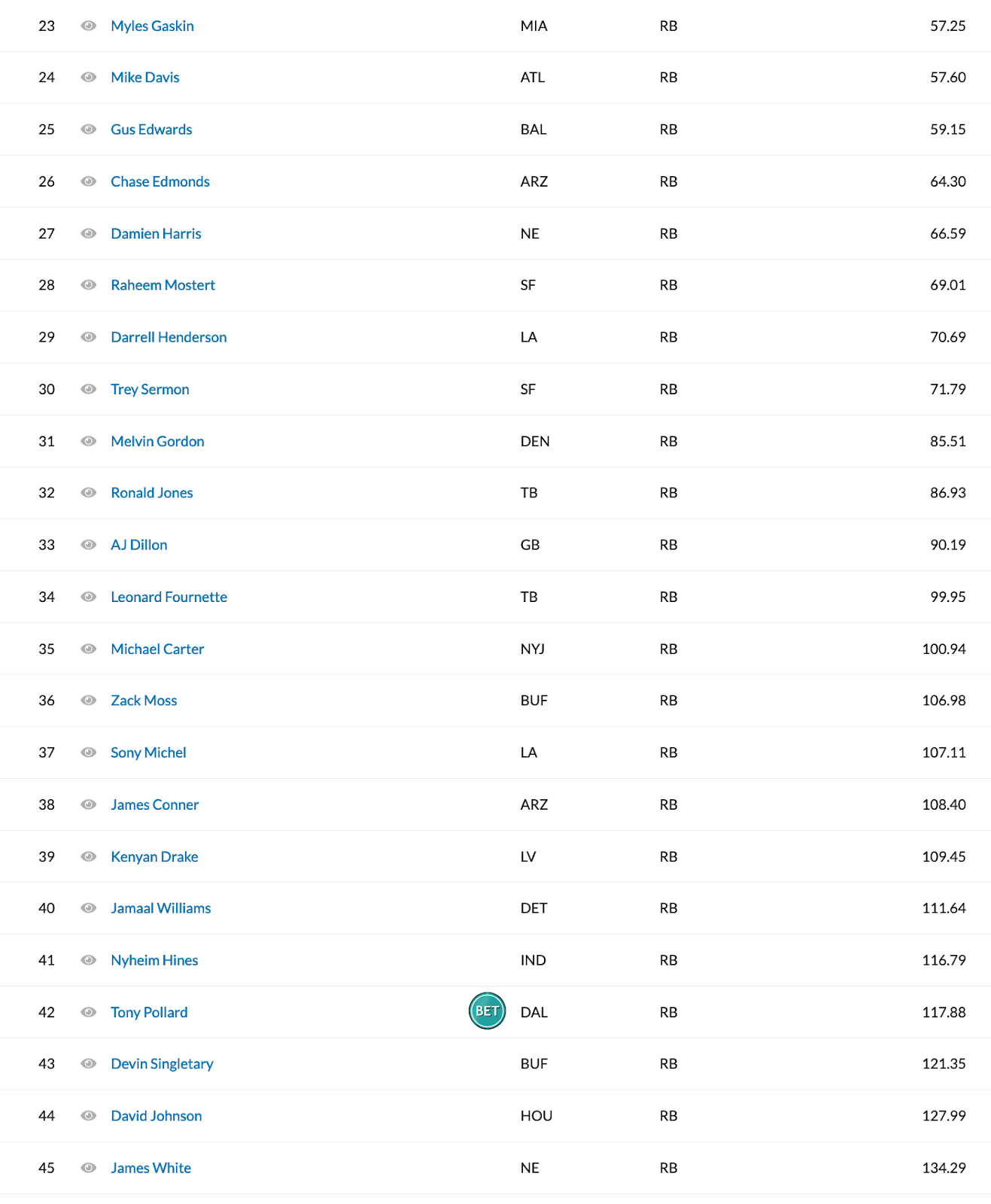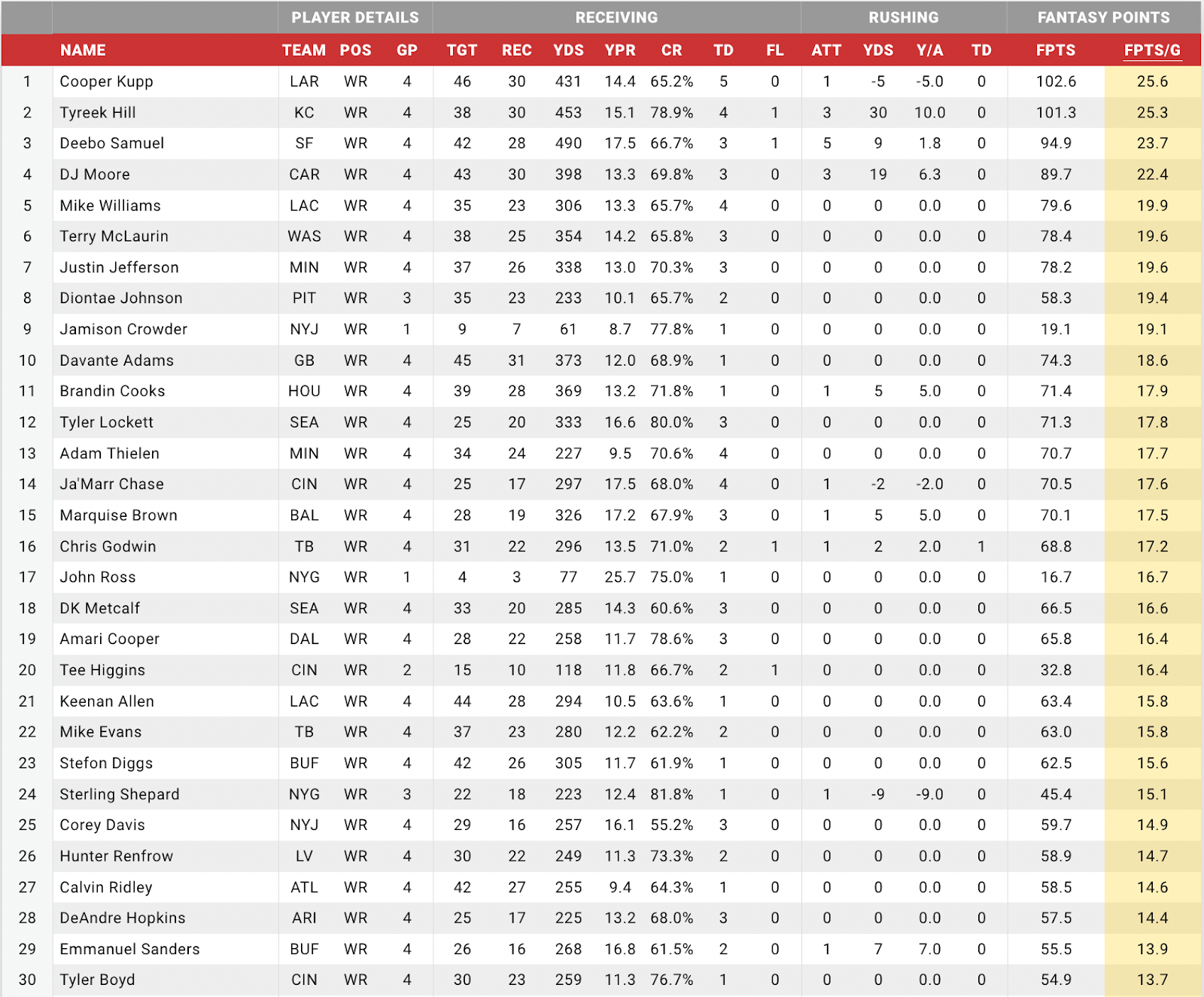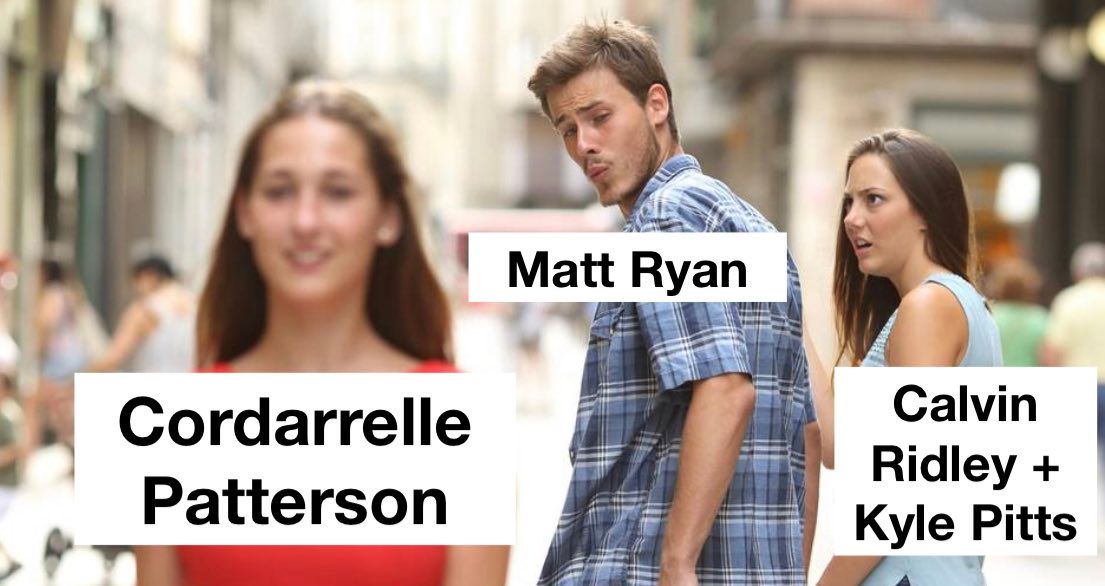This week’s Stat-Pack is going to look a bit different. Instead of going team-by-team and scouring usage and fantasy notes, I’m taking a step back and looking at how Weeks 1-4 have gone from a high level.
I love dividing the season into 4 logical quarters (Q1: Weeks 1-4 | Q2: Weeks 5-8 | Q3: Weeks 9-12 | Q4: Weeks 13-17) and evaluating things from that perspective. The final quarter is where the bills get paid, but the first quarter is arguably just as important. It’s all about finding signals and ignoring noise. Overreacting to a small sample of games can be detrimental to your success while underreacting and not making the necessary adjustments is a potential blindspot.
So, here are some ideas I’m thinking of at the end of the first quarter…Quarterback scoring remains at an all-time high. Will it continue? Is running back scoring lower or does it just feel that way? What is up with WR scoring… Diggs, Ridley, and Hopkins specifically? Which draft strategies are working? Which aren’t?
Let’s take a look back at the opening month that was:
Quarterback Scoring Continues All-Time Highs
Last year, we saw quarterbacks post record-breaking numbers with six signal-callers – Allen, Rodgers, Murray, Mahomes, Watson, and Wilson – all finishing inside of the top-20 all-time in single season fantasy points. Had Dak Prescott stayed healthy, he surely would have made it 7 record-breakers because he averaged 24.7 FPG (making him the QB1) in his five starts.
The lack of fans and lack of defensive practice time certainly weighed into these passers putting up record numbers in 2020, but the larger influence is the NFL’s continued emphasis on making it easier on offense. Not only are defensive pass interference calls up while offensive PI’s are rarely called, we also saw an all-time low in offensive holding calls – which are often drive stoppers.
Well, 2021 looks no different. In fact, it’s just gotten even better for quarterbacks.
Right now, the top-15 quarterbacks by fantasy points per game are not only setting new highs – but they are doing so by a massive margin. The top-15 scoring QBs are averaging 22.77 FPG, which is a full point above the epic 2020 campaign. The first table below shows just how much quarterback scoring has evolved in recent history.
However, beyond the fact that life is easier on offense, there is one main reason quarterbacks are scoring more and it's easy to guess…
Fantasy points per game among top-15 QBs since 2015
| Year | Avg FPG |
| 2015 | 19.35 |
| 2016 | 18.85 |
| 2017 | 18.33 |
| 2018 | 19.84 |
| 2019 | 19.46 |
| 2020 | 21.62 |
| 2021 | 22.77 |
… that the scoring uptick has a direct correlation with how often quarterbacks are running…
Carries per game among top-15 QBs since 2015
| Year | Avg Carries per Game |
| 2015 | 3.61 |
| 2016 | 3.43 |
| 2017 | 3.46 |
| 2018 | 3.71 |
| 2019 | 4.14 |
| 2020 | 4.20 |
| 2021 | 4.88 |
…. and the fantasy points these QBs score on their runs:
Rushing fantasy points per game among top-15 QBs since 2015
| Year | Avg Rushing FPG |
| 2015 | 2.46 |
| 2016 | 2.67 |
| 2017 | 2.48 |
| 2018 | 2.76 |
| 2019 | 3.29 |
| 2020 | 3.84 |
| 2021 | 4.13 |
Through four games, Patrick Mahomes (28 FPG) is on pace to edge out Lamar Jackson’s all-time best 27.7 FPG from 2019. It will be very hard for Mahomes to sustain his 9.9% TD rate, but this is the same guy that already has the fifth- (26.1 FPG) and eighth-best (24.9) scoring seasons in his bag with 8.6% and 6.5% TD rates in those seasons.
Kyler Murray is also out-doing himself and is currently putting up 3.3 more fantasy points per game now (27.0 FPG) than he did last year (24.7) while Jalen Hurts is cementing himself as a league-winner with 24.8 FPG.
For reference, Hurts’ 24.8 FPG is basically the same exact figure that Mahomes (24.9) put up last season. In his very young career, Hurts has shown a high level of consistency posting QB11 > QB2 > QB12 > QB5 > QB10 > QB10 > QB3 weekly performances in his seven full starts while averaging 62.3 rushing yards on 10 carries per game. He’s officially baby Lamar.
Even the QB5 (!!) Sam Darnold is getting on the running quarterback party with five rushing scores already. Obviously, Darnold will be lucky to score 2-3 more over the course of the season – but he is running way more and that should be sticky. Darnold has 5 or more carries in 3-of-4 starts.
On the whole, 18 quarterbacks are averaging 17 or more FPG… and Ryan Tannehill, Baker Mayfield, Trevor Lawrence, Justin Fields, and Trey Lance aren’t among them. If the Bears start actually utilizing Fields’ strengths and Lance plays well enough to usurp Jimmy Garoppolo, there is even more scoring to go around towards the upside.
Justin Herbert and Aaron Rodgers are both playing at MVP levels, but are yet another example of how not running can dampen weekly upside. Not only are you losing out floor- and ceiling-boosting points on the ground, but you are also losing points when your opponents starts Kyler Murray and he runs for 80 yards, 2 TDs, and drops 39 fantasy points or something ridiculous. Herbert and Rodgers are the QB16 and QB17 in scoring and have both had week-winning spike games, but they are going to remain back-end elite options because they rarely scramble.
We’re living in the Golden Age of QB scoring and it’s simultaneously made the cheat codes (like Mahomes, Murray, Jackson, Allen, and Hurts) more valuable and given us a huge cohort of usable streamers from Carr, Cousins, and Burrow types to Heinicke, Jones, and (hopefully) Fields / Lance.
Live and Die with Early-Round Running Backs
Meanwhile, running back scoring has been tame in the opening month. Unfortunately that’s because Christian McCaffrey might end up missing multiple games, Dalvin Cook is banged, and Joe Mixon might miss some time, too. Also, some of the safer 3rd/4th round options in drafts – like Chris Carson and David Montgomery – are also managing injuries.
This is just the blessing and the curse of running backs. At least we have Derrick Henry retaining the crown and Austin Ekeler looking like a bonafide league-winner.
On the plus side, the ROI on early-round running backs is relatively high right now according to historical standards because the mid-round range (Rounds 5-9) was objectively a terrible investment this summer and looks even worse right now if you spent a lot of capital buying in that range.
Just look at how gross this list is. These were the backs that were routinely taken in the Round 5-9 pocket in NFFC drafts in August-September:
Lots and lots of pain here.
Myles Gaskin and Mike Davis look like colossal busts relative to their ADP counterparts. By drafting Gaskin or Davis in the fifth round, you were passing up on receivers like Adam Thielen, D.J. Moore, Cooper Kupp, Tyler Lockett, and Diontae Johnson. Oh, and you were losing out on QB points – unless you took Mahomes – because this was the sweet spot for Jackson and Murray. Yikes.
Darrell Henderson is a bonafide league-winner and is making Yards Created fanatics a lot of money this year, but no one else from this range is providing league-winning upside. Chase Edmonds, Kareem Hunt, Damien Harris, Jamaal Williams, and Zack Moss are useful contributors – but all are stuck in RB2-RB3 purgatory from a scoring perspective for different reasons.
All of this is shaping up as another year where Superhero RB is the preeminent, best strategy in fantasy. You take just one running back in the first 2 rounds and then in Rounds 3-9 you hammer WRs, take a QB and/or a TE while sprinkling in one or (at most) two more backs in the mid-rounds. To fill out your roster, you take shots on all of the handcuff / bench stash types in Rounds 10 and on to fill your depth out with guys like Alex Mattison, Damien Williams, or Kenneth Gainwell and then churn the hell out of the waiver wire during the season.
(I wrote about the Superhero RB strategy and data behind it this offseason from a best-ball perspective and I think I underestimated how viable it is in managed leagues. It also works somewhat in conjunction with Scott Barrett’s Bellcow Or Bust theory where you only draft running backs that have bellcow usage in their range of outcomes and ignore everyone else. That “everything else” includes basically the entire mid-round range for RBs because they aren’t early-round options for a reason. I will expand on all of this more next summer.)
What makes Superhero work is that early-round RB investments (like Derrick Henry and Austin Ekeler right now) always provide the greatest chance of producing league-winning seasons while backs like Najee Harris and Saquon Barkley are on the precipice of that elite status. With that in mind, the mid-round range (5th-9th) is chock full of RB landmines as drafters are overly confident at identifying who has upside and who doesn’t. Looking at you, Ronald Jones.
On the whole, 54% of the top-24 scorers were drafted in Rounds 1-2 through the opening month and that is well ahead of the recent baseline for all of the reasons outlined above:
RB Hit Rate By Round (2015-20)
| Round | Percentage |
| 1st / 2nd Rounds | 38.2% |
| 3rd / 4th Rounds | 22.9% |
| 5th-7th Rounds | 16.0% |
| 8th-10th Rounds | 8.3% |
| 11th-16th Rounds | 8.3% |
| Undrafted | 6.3% |
Through the first quarter, D’Andre Swift, Clyde Edwards-Helaire, and James Robinson are looking like safe bets to exceed their draft cost from the Round 3-4 range while David Montgomery and Chris Carson’s seasons are in limbo due to injury. And get out the sad trombone for Miles Sanders and Josh Jacobs.
Live or die with early-round running backs.
An Overview of the WR Landscape: Which Hot / Slow Starts are Real or Variance?
Here are the top-30 WRs by FPG from our leaderboards:
Plenty of people sharper than I have talked about how deep wide receiver is in fantasy and that is what originally led me to the Superhero strategy. If receiver is deep, wouldn’t it make sense that there are going to be more league-winners deeper in drafts?
We are seeing the returns on that idea with Cooper Kupp (4th-5th round ADP), Mike Williams (8th), D.J. Moore (5th), Deebo Samuel (8th-9th), Brandin Cooks (9th), and Marquise Brown (8th) all looking like incredible values.
Of course, we have gotten some air balls from the mid-round WRs, too, either because of injury (Jerry Jeudy and Tee Higgins) or poor performance (Brandon Aiyuk) but the lowest of lows aren’t anything close to their running back counterparts by ADP. While Mike Davis and Myles Gaskin are both drop candidates in shallow leagues, at least you’re still getting some usable production from middling mid-round WR3s like Kenny Golladay, Courtland Sutton, Tyler Boyd, Corey Davis, DeVonta Smith, Antonio Brown, or Marvin Jones.
Kupp, Williams, Moore, Samuel, and Cooks specifically aren’t some random outliers either. They are here to stay. They might regress some, but their usage is the signal…
Cooks is first in target share among wide receivers (35.1%)
Kupp is third (34.1%)
Samuel is fourth (30.7%)
Moore is seventh (29.5%)
Williams has seen 24% or more of Chargers targets in 3-of-4 games
While Davante Adams and Tyreek Hill have both had their share of spiked weeks and clunkers, both are shaping up like hits. Hill especially. On the other hand, we are waiting on Stefon Diggs (WR24 by FPG), Calvin Ridley (WR28), and DeAndre Hopkins (WR29) to get going.
Diggs is looking like an epic buy low but I’m conflicted on Ridley. On the one hand, the volume has been incredible – Ridley has 8, 10, 11, and 13 targets in Weeks 1-4 – but the Falcons are abysmal and Matt Ryan has turned into the most conservative quarterback in the league. Ryan’s 5.9 average depth of target ranks dead last in the league and, for perspective, that is nearly a full yard below Ben Roethlisberger (6.7). Not good!
Either because of his rib injury or because the Cardinals are changing their philosophy (or both), DeAndre Hopkins just hasn’t seen near the volume in 2021 compared to his Arizona debut. Nuk has been held under 9 targets in all four games this season after seeing 9 or fewer looks just four times all of last season. I think there is enough signal here – between Christian Kirk and Rondale Moore being involved and A.J. Green not being dead yet – to not expect Nuk’s volume to rebound back to alpha WR1 status.
A few receivers that are setting up as buy-lows…
CeeDee Lamb and Amari Cooper – Wide receiver scoring is much more variable than quarterbacks and running backs and Lamb is a microcosm of that. After a hot start, Lamb has just 5/79 on 8 targets over his last two games but those were two games where Dallas controlled throughout and Dak Prescott barely had to throw. The back half of the Cowboys schedule in crunch time from Weeks 11-17 looks hot and filled with potentially pass-heavy gameplans and/or weak pass defenses: vs. Chiefs, Raiders, Saints, Washington, New York, Washington, and Arizona. The public is always too low on Cooper and I’m sure that hasn’t changed after recent injuries.
Stefon Diggs – Just like Calvin Ridley, Diggs’ target volume is amazing (13 > 8 > 10 > 10) but he just hasn’t gotten the deep looks. The reason why Ridley hasn’t scored on deep targets compared to Diggs couldn’t be more different, though. While it looks like Matt Ryan is entering a deep decline, Josh Allen is just getting started. Allen’s average depth of target (9.4 yards) is third-highest in the league and Diggs has seen 10 targets that have traveled 20 or more yards while Ridley has just 5. And, per SIS, just three of Diggs’ 10 deep targets have been catchable. I’m betting that Allen and Diggs’ chemistry returns sooner rather than later.
Robert Woods – OK, maybe I’m doubling down here. But I’m staying the course with Woods because his usage has been quietly strong after he randomly ran behind Van Jefferson in Week 1. Since then, Woods has run a route on 92% of Matthew Stafford’s dropbacks in Weeks 2-4, but he just hasn’t seen the targets yet. Kupp is definitely going to see more targets than Woods and probably by a wide margin at the end of the season, but Woods’ 18.5% target share is bound to go up some because he’s playing so much. And again, just like with the Cowboys, I want pieces of productive passing offenses no matter what and the Rams closing schedule is amazing after their Week 11 bye – vs. Packers, Jaguars, Cardinals, Seahawks, Vikings, and Ravens. Whew.
Cordarrelle Patterson Time
I’ve saved the best for last. Or worst. It just depends on your perspective.
Ok, what if I told you that a player who has played 24, 24, 26, and 23 snaps through four games was the RB3 and WR5, depending on how you look at it, with 20.9 FPG? You would probably think that’s only possible in Madden or something. Nope! That’s Cordarrelle Patterson.
It’s better than poetry. The Atlanta Falcons, the much maligned Atlanta Falcons. The team that invents new ways to lose, crush dreams, and disappoint on a yearly basis… are the first and only team that has correctly figured out how to use Patterson.
You don’t need me to tell you that Patterson can’t keep up his scoring pace – he has 5 TDs on just 45 touches – but, all kidding aside, just how valuable is Patterson’s part-time role? Well, according to XFP (expected fantasy points), Patterson should have scored just 13.0 FPG in Weeks 1-4. Which shakes out as a worthwhile FLEX / RB3 / WR3 – whatever he’s designated as in your league. But it’s a far cry from the 20.9 FPG he’s actually scored.
Both things can be true: 1) Patterson is playing extremely well and deserves more snaps and 2) he’s a great sell-high candidate because we’ve likely seen two of his highest scoring games (23.9 FP in Week 2 and 34.6 FP in Week 4). The Falcons would be wise to phase Mike Davis out even more, but Patterson will never be a running back you give 15 carries per game. Patterson is here to stay, but I’m betting his production dips down to the 12-15 FPG range over the final 13 games unless his snaps dramatically increase.










